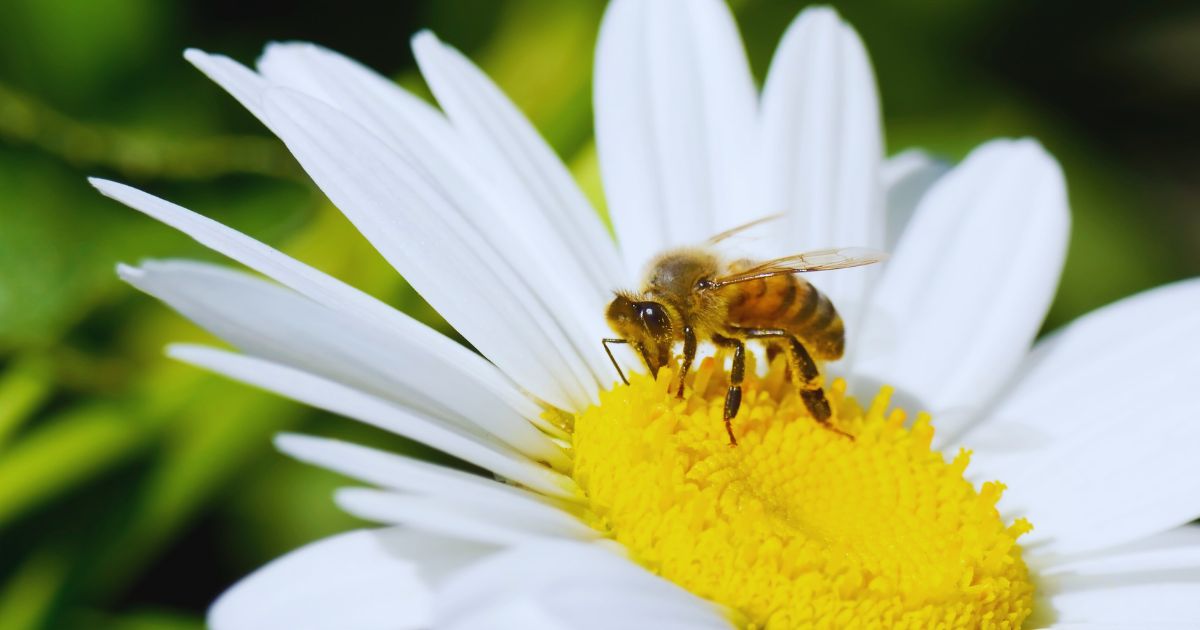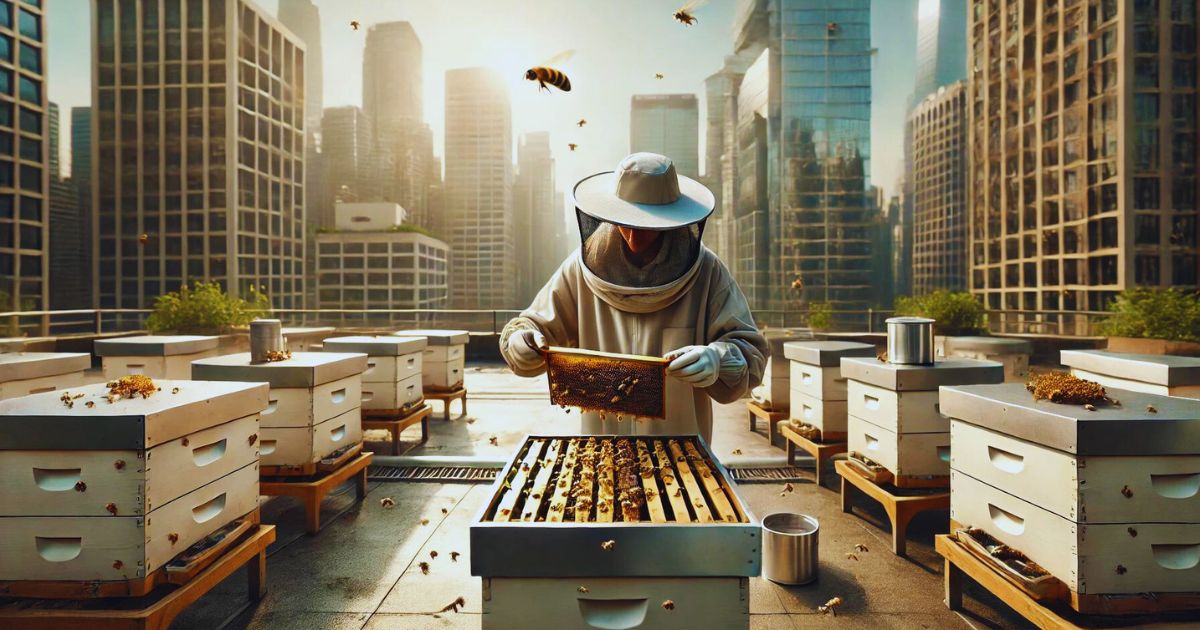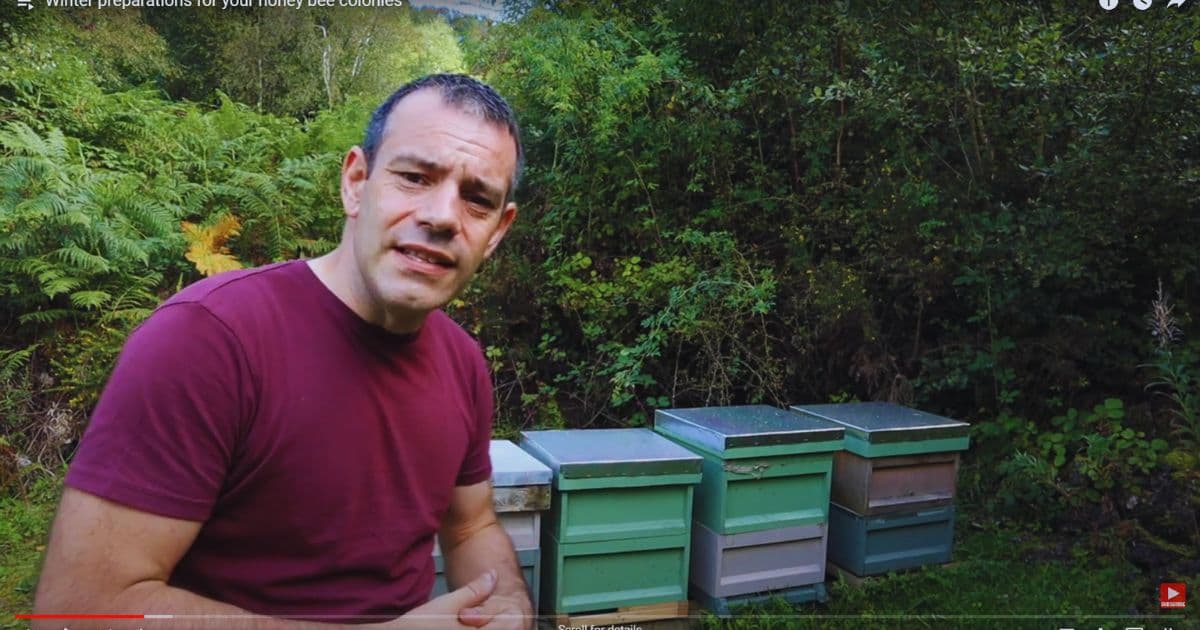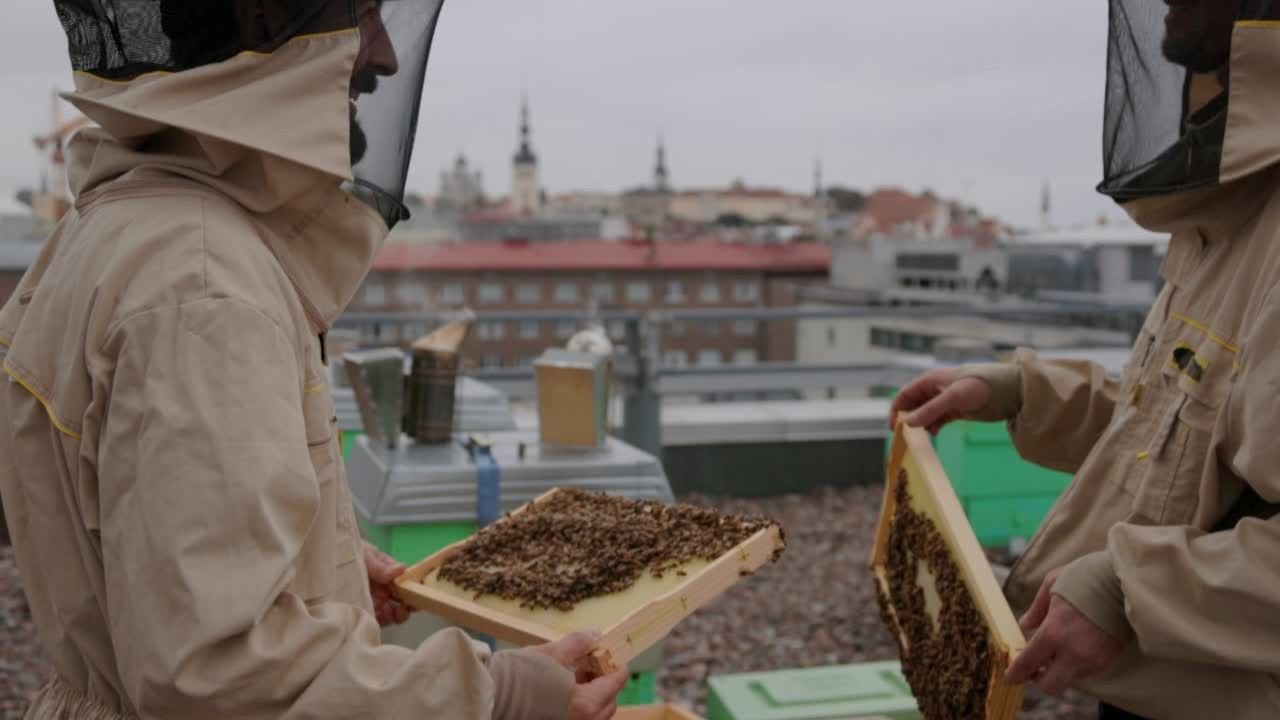Tony O’Neill is the founder of Simplify Beekeeping and an experienced beekeeper with over a decade of hands-on experience. Starting with just a few hives to support his garden, Tony’s passion for beekeeping quickly grew into managing 45 hives. He’s dedicated to making beekeeping accessible and enjoyable for everyone, sharing his knowledge through practical tips, in-depth guides, and engaging videos. When he’s not tending to his bees, Tony enjoys teaching others about the joys of beekeeping, both online and in his local community.
Are you looking for a way to help the environment from your city home? Many think living in urban areas means they can't contribute much to nature. But, there's a buzz about an activity that brings green life into concrete jungles: urban beekeeping.
It’s not just about honey bees; it also includes caring for wild bees like mason and leaf-cutter bees.
Urban beekeeping turns rooftops and balconies into spots where these vital pollinators can thrive. Paris leads with over 3,000 hives! This hobby supports our food system, adds diversity to city plants, and teaches communities about sustainability.
Our blog will guide you through starting your hive in the city and making your grey world greener. Let’s get started!
Key Takeaways
- Urban beekeeping helps city gardens grow by moving pollen. It also improves food systems and adds different plants to cities.
- Cities have rules for keeping bees. Before starting, you need to check these laws and maybe get permits.
- Bees need safe places in the city with lots of flowers. People should plant more local flowers that bloom at different times.
- Talking to neighbors and teaching them about bees can improve your bee project. Share honey and show how bees work.
- Check on your bees often to keep them healthy. Look for diseases and ensure they have enough water and food throughout the year.
Benefits of Urban Beekeeping
Urban Beekeeping provides essential pollination for local gardens, green spaces, and urban farms. It also supports biodiversity and offers communities educational benefits about the role of bees in our ecosystem.
Pollinates local gardens and green spaces
Bees play a significant role in making gardens and green spaces lively. They move pollen from one flower to another. This helps plants grow, breed, and make food. Bees are behind the scenes of over 85 agricultural crops coming to life.

With urban beekeeping, city food systems get a big boost.
Cities have many different flowers for bees to visit. This variety is suitable for bees and helps them thrive. When bees buzz around urban gardens, they help many plants bloom and grow fruit or seeds.
Green places in cities become more beautiful thanks to these tiny workers.
Supports local biodiversity
Promoting local gardens and green regions contributes significantly to a healthier environment, sustaining various life forms, especially bees. Urban beekeeping is significant in furnishing our ecosystems with ample richness and diversity, serving as a habitat for honeybees and 200,000 other pollinators.
Cities offer sanctuaries that contribute substantially to the repopulation of species vital for pollination. Research conducted in 2012 by Biomed identified 56 distinct bee species alongside ants and wasps within these urban communities.
This diversity demonstrates that cities possess the potential to accommodate a broad spectrum of buzzing residents if given the opportunity. With wild bees emerging in spring and honeybees becoming more noticeable in late summer, it’s apparent that urban locales possess distinctive seasonal patterns for these creatures.
Urban beekeeping stimulates flowering plants to bloom, exerting a direct, positive impact on floral diversity. A flourishing ecosystem benefits everyone, from minute insects to human inhabitants. Urban environments are ideal for keeping bees in small spaces.
Promoting pollinator ecosystems augments plant pollination and boosts floral diversity.
Provides educational opportunities for communities
Supporting local biodiversity with urban beekeeping leads to great learning opportunities. Urban beekeeping shows city folk how nature works. People learn about bees by watching them, which helps everyone understand science better.
Norman Carreck says joining local beekeeping groups is good for learning more.
Urban hives teach essential lessons about green cities and urban farming. Corporate offices now use nature spots to teach workers about the outdoors. Noah Wilson-Rich discusses this in his TED Talk.
Beekeeping classes help people become citizen scientists. They learn to care for bees and make honey while helping plants grow.

Challenges in Urban Beekeeping
Urban beekeepers face hurdles in understanding and complying with local laws and regulations. They also need to effectively manage interactions between humans and bees while ensuring enough food and suitable habitat for the bees.
Navigating local regulations and laws
In 2010, 2013, and 2015, keeping bees became legal in cities like New York, Boston, and Los Angeles. Yet each city has its own rules about beekeeping. Some might limit the number of hives you can have or how close they can be to other buildings.
So, before setting up a hive on a rooftop or in a backyard, it’s key to check these regulations. You might need to look online or talk to the city clerk.
Obeying these laws also includes getting the proper permits. This might seem tough at first glance, but finding information is not too hard with some research. Laws ensure that people and bees live well together in cities.
Before starting your apiary journey in the city, always ensure compliance with local bylaws.
Managing human-bee interactions
Urban bees are chosen for their gentle nature, keeping people safe. Nonetheless, wearing protective gear such as bee suits when examining them or harvesting honey is essential to avoid being stung.
This precaution is crucial even when bees start swarming, as they are typically not inclined to harm anyone. Still, such scenarios need immediate attention.
Informing neighbors about bee behaviors can help alleviate their concerns. Employing privacy screens makes hives less noticeable, which helps maintain harmony in the neighborhood.
On occasions, if a nearby resident is severely allergic to bee stings, relocating your hive might be necessary for their safety. These measures ensure a peaceful cohabitation for humans and bees in urban environments.
Ensuring adequate forage and habitat
Cities can offer bees lots of different plants to visit for pollen and nectar. People in cities, like homeowners or big companies, play a significant role by planting local flowers that bloom at different times.

This helps bees find food across the seasons. Real estate growth takes away bee homes, which is a big problem. Yet, putting gardens for pollinators on rooftops or at ground level can help fix this issue.
The Best Bees Company points out how vital it is to make places where bees can find food and live safely. With more wild bees showing up in spring and honeybees around in late summer, having enough flowering plants all year round is crucial for survival.
These efforts support the bees and the broader goal of boosting green spaces in urban areas.
Best Practices for Urban Beekeepers
Selecting an appropriate hive location, educating the neighborhood and community members, and regularly checking on bee health are essential best practices for urban beekeepers. Read on to explore more about these best practices.
Choosing the right location for hives
Choosing the right location for hives is key in urban beekeeping. It ensures bees stay healthy and productive.
- Check local laws first. Cities like Detroit, Chicago, and New York City allow beekeeping but have rules about where to place beehives.
- Look for spots with good sun exposure. Bees need warmth to thrive, but not too hot.
- Make sure there’s a water source nearby. Bees need water just like we do.
- Find areas with lots of plants. Flowers give bees the food they need to make honey.
- Keep hives away from busy paths. You want to reduce the chance of people bumping into them.
- If possible, build your hives on rooftops or garden levels. This can reduce ground maintenance and protect bees from pests.
- Leave space around the hives for work. There should be a few feet of clear space on all sides for easy access.
- Assess neighborhood gardens and trees to ensure enough forage is available year-round.
- Placement must follow distance rules from boundaries, roads, and entrances per local regulations.
- Consider setting up pollinator-friendly plants around your hive area to support your bees further.
By paying attention to these points, you can pick a spot that helps urban bees and their keepers succeed.

Educating neighbors and community members
After picking the right spot for your bee homes, it’s a smart move to talk to your neighbors and community. This can make everyone feel good about your bee project.
- Host open garden days where people can see the bees and learn how they live. Show them the hives and how bees help plants grow.
- Share facts about why bees matter. Tell them how bees pollinate food crops and city plants.
- Offer honey from your bees to neighbors. It’s a sweet way to thank them for their support.
- Put up signs in local parks or community centers about urban beekeeping benefits.
- Invite Dr. Noah Wilson-Rich to discuss using city spaces like rooftops for beekeeping.
- Start a newsletter or blog with updates on your bees and tips on helping local pollinators.
- Work with schools to teach kids about bees, showing them bee suits and explaining what worker bees do.
- Organize workshops on making wildflower seed bombs to improve food sources for your bees.
- Create a social media page where you post photos of your apiaries and share stories of your beekeeping journey.
- Partner with businesses for talks or events that spread the word about urban agriculture, including keeping bees in the city.
Doing these things can build a strong group of supporters around your hobby or business in urban beekeeping.
Regular maintenance and health checks of bees
You need to check on bees often to keep bees healthy in the city. Here are the steps:
- Wear a beekeeping suit during inspections. This keeps you safe from stings.
- Check bee health monthly. Look for signs of disease or stress in your bees.
- Manage swarms, especially in the second year. This keeps the hive under control.
- Look at water sources for bees nearby. Bees need water to cool their hives and digest food.
- Make sure there’s enough food for the bees. Plant flowers or set up feeders if needed.
- Check for varroa mites, a significant threat to bee health.
- Replace old or broken beekeeping equipment regularly.
- Join a local beekeeping society. Get help and advice from other beekeepers.
- Share your honey with neighbors and friends. This helps everyone learn about bees.
- Work with others when you can. Hive management can be easier with help.
These steps help keep city bees happy and healthy all year long.
Getting Started with Urban Beekeeping
Starting urban beekeeping involves understanding legal considerations, obtaining permits, selecting and setting up beekeeping equipment, and joining local beekeeping societies for support. It’s also crucial to ensure a sustainable water source for bees, choose the right location for hives, and establish a suitable environment to support their health and well-being.
Legal considerations and obtaining permits
Urban beekeepers must follow regulations specific to their city, as legal restrictions vary. Here are the key points to consider for legal aspects and obtaining permits for urban beekeeping:
- Review local regulations and legal requirements before establishing beehives.
- Obtain necessary permits from the local authorities before setting up hives.
- Seek guidance regarding legal compliance from city clerks or reputable online resources.
- Join local beekeeping societies, as they can provide valuable assistance in understanding legal complexities.
- Ensure that the placement of beehives complies with all relevant local bylaws.
- Regularly review local regulations to stay updated and compliant with any changes.
These considerations form the framework for ensuring that urban beekeeping activities are legally compliant and operate within the parameters of applicable laws and regulations while promoting the well-being of bees and communities.
Selecting and setting up your beekeeping equipment
When starting urban beekeeping, selecting and setting up your beekeeping equipment with great care is crucial. Here are the key steps:
- Order equipment in January or February to ensure availability before obtaining bees.
- Choose standard hive dimensions, such as 14″ x 20″ (Langstroth) or 48″x 18” (top bar).
- Ensure a water source within 5-10 feet of the hive.
- Acquire essential tools such as a smoker and protective gear for hive inspections.
- Consider cooperative honey houses to reduce harvesting costs.
- Regularly maintain and perform health checks on your beekeeping equipment.
These steps are essential for effectively starting and maintaining an urban beekeeping setup, ensuring the well-being of the bees and successful honey production.
Joining local beekeeping societies for support and resources
Transitioning from setting up beekeeping equipment to building a support network, it’s essential to highlight the value of joining local beekeeping societies for guidance and resources.
Norman Carreck emphasizes the significance of these associations because they offer vital support and educational opportunities for urban beekeepers. By engaging with these societies, you access mentoring from experienced individuals, cooperative honey houses, educational sessions, networking events, and community resources.
This interaction provides insights into best practices and aids in navigating the intricacies of urban beekeeping environments.
Conclusion
Urban beekeeping offers a simple yet impactful way to bring nature into the heart of our cities. By managing bees in urban areas, we not only aid in pollinating local gardens but also support biodiversity.
With careful planning and adherence to local regulations, urban beekeeping can reveal the secrets to greener and more sustainable city living.
Through direct involvement with beehives in our communities, we can boost awareness about the rapidly declining bee population and foster a deeper connection with nature. As we embrace this journey towards more environmentally friendly urban spaces, let’s consider that every small rooftop garden or beehive contributes to an ever-improving ecosystem within bustling cities.

FAQs
1. What is urban beekeeping?
Urban beekeeping is the practice of keeping bees in the city. It involves setting up hives, like Langstroth or top bar hive, in areas such as street trees and other green design spaces.
2. How does urban beekeeping help with the rapidly declining bee population?
By creating agricultural areas within the city for different types of bees, including solitary bees like mason bees (Osmia) and bumblebees (Bombus), we can combat the decline in their numbers caused by monoculture practices in commercial beekeeping.
3. Can you harvest honey from urban beehives?
Yes, you can! Bees produce honey that can be harvested from these hives. The type of honey will depend on what kind of flowers are available to them in their environment.
4. Are all types of bees suitable for urban agriculture?
Not all kinds are ideal for this purpose but solitary species like mason and bumblebees adapt well to this setup since they don’t require large colonies like drone bees do.
5. Is there any role analytics play in Urban Beekeeping?
Yes! Analytics could provide valuable insights into hive health, productivity levels and aid targeted advertising efforts promoting benefits of supporting local urban agricultural initiatives.






Leave a Reply